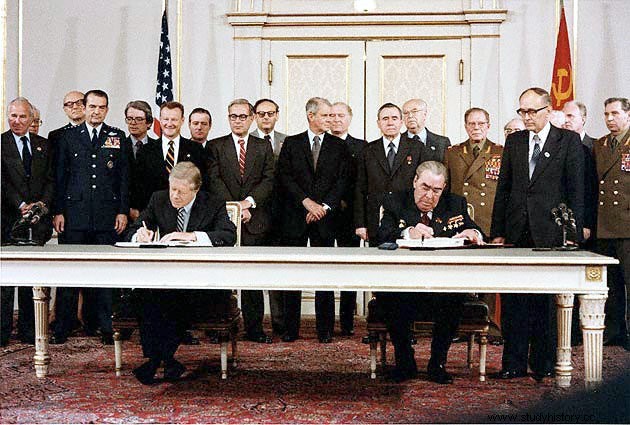- General climate of “detente” in the Cold War after the Cuban crisis.
- Establishment on June 20, 1963 of the “red telephone” aimed at facilitating dialogue between the USSR and the United States.
- The Nuclear Non-Proliferation Treaty (NPT) was signed in 1968.
- Leonid Brezhnev succeeded Nikita Khrushchev in 1964 as head of the USSR
- Richard Nixon was elected President of the United States in 1968.
- At the beginning of the 1970s, relations between East and West intensified:the Soviet leaders resumed the modernization of their country and became aware of the accumulated backwardness in terms of technology.
- For the United States, the USSR is seen as a potential market for their mass production.
May 26, 1972

Characters
Richard Nixon
Leonid Brezhnev
Procedure
The SALT I treaties were signed on May 26, 1972 in Moscow by Richard Nixon and Leonid Brezhnev. Each party has an interest in reducing the production of strategic weapons:the USSR has financial difficulties and the United States must bear the high costs of the Apollo program and the Vietnam War.
The SALT I treaty provides for two aspects relating to disarmament and the limitation of the military arsenal:
- limitation on the manufacture of strategic weapons and the installation of ballistic missile launch pads;
- limitation of “anti-ballistic missile” (AMB) missiles.
Consequences
- The SALT Treaty is part of the continuity of the necessary control of the military arsenal after the Cuban crisis.
- Several disarmament and limitation treaties will follow:SALT II (1979), START (1991), New START (2010)…
- However, SALT I did not prevent the Euromissile crisis between 1977 and 1987 (installation of Pershing missiles for the United States and SS20 for the USSR).
- Reagan launched the Strategic Defense Initiative (“Star Wars”) program in 1983.
